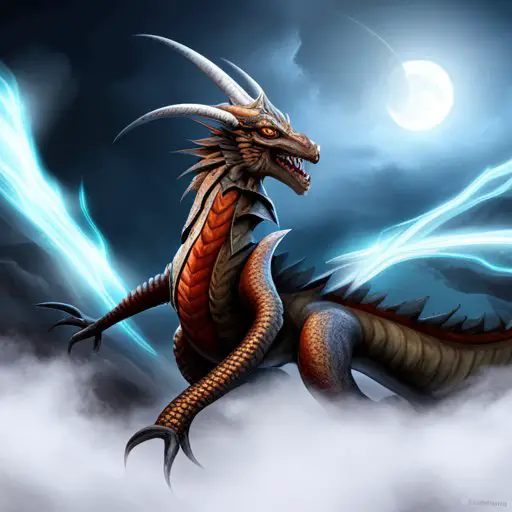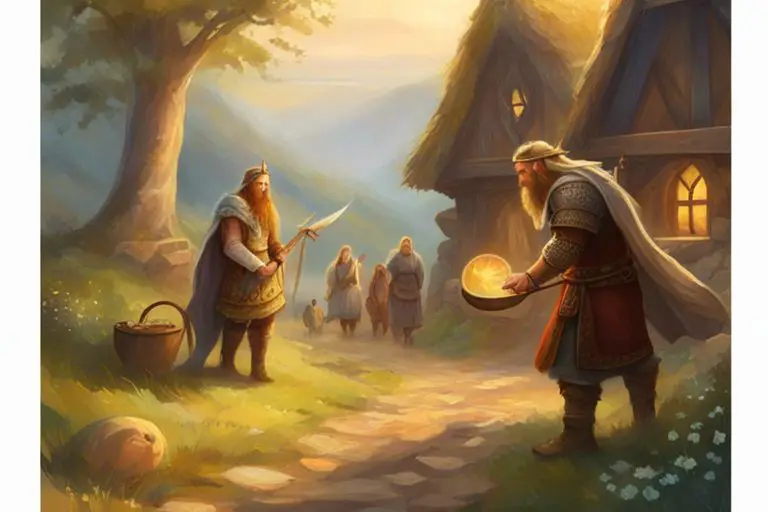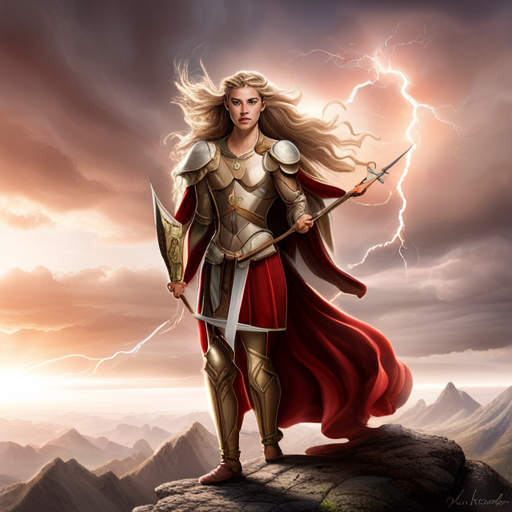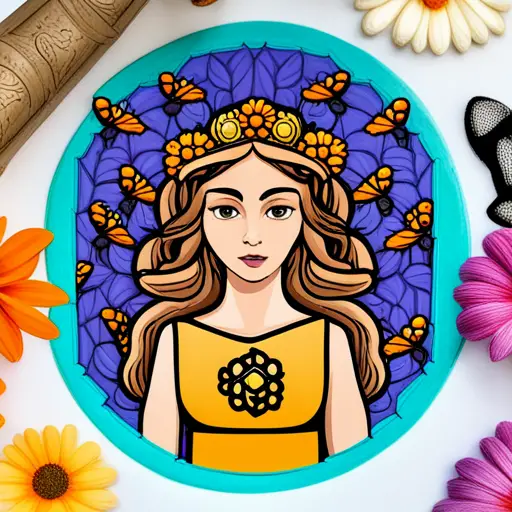Did you know that dragons have been a part of Norse mythology for centuries? These fearsome creatures have captured the imagination of people for generations, and continue to be a popular subject in modern culture.
In Norse mythology, dragons are known as dreki, and they are some of the most powerful and feared creatures in the Norse pantheon. According to Norse mythology, dreki were born from the blood of the giant Ymir, and were said to be immortal beings with incredible strength and magical abilities.
They were often depicted as guardians of treasure hoards, and were known to breathe fire and poison. In this article, we will explore the origins, characteristics, and role of dreki in Norse culture, as well as some famous examples from Norse mythology and legends.
Join me as we delve into the world of dreki, and uncover the enduring legacy of these fearsome dragons.
The Origins of Dreki in Norse Mythology
You’re probably wondering where these terrifying creatures came from – well, according to Norse folklore, their origins are shrouded in mystery and mysticism.
Some believe that the dreki were born from the blood of Ymir, the giant who was the first being in the universe. Others suggest that they were created by the god Odin, who was known for his love of knowledge and magic. Regardless of their origin, the dreki quickly became a symbol of power and fear in Norse mythology.
They were said to be intelligent creatures, capable of great destruction and cunning. As I delve deeper into the characteristics and abilities of dreki, you’ll see just how fascinating and fearsome these creatures truly are.
Characteristics and Abilities of Dreki
Like a blazing inferno, Dreki possess immense power and cunning abilities that strike fear into the hearts of even the bravest warriors. These Norse dragons are depicted as fierce and dangerous beasts with scales that are as hard as steel.
They are said to have a keen sense of smell and hearing, and their eyes can see through the darkness of the night. Their wings are massive and powerful, enabling them to fly for long distances and even carry a fully grown man on their back.
In addition to their physical abilities, Dreki are also known for their magical powers. They can breathe fire, ice, or poison, depending on their nature, and can control the elements with their tails. Some legends say that they have the power to shapeshift into human form, allowing them to move among mortals undetected.
With these abilities, it is easy to see why the people of Norse mythology feared and respected these magnificent creatures. As formidable creatures, Dreki played an important role in Norse culture and beliefs. They were often associated with Viking raids and were believed to protect treasures and secrets hidden deep within the earth.
Some stories even suggest that the gods themselves rode on the backs of Dreki, using their power to control the elements and defeat their enemies. Despite their fearsome reputation, however, Dreki were also seen as symbols of strength, wisdom, and protection.
They were revered and celebrated in Norse mythology, and their legacy continues to capture the imagination of people today.
The Role of Dreki in Norse Culture and Beliefs
As you immerse yourself in the rich tapestry of Norse culture, you’ll find that these powerful creatures are woven into the very fabric of their beliefs, inspiring awe and reverence in those who encountered them.
The role of Dreki in Norse culture is significant, as they were believed to be creatures of great power and wisdom. They were considered to be the guardians of the underworld, and their presence was often associated with protection and good luck.
The Norse people also believed that Dreki were connected to their gods, particularly Odin, the god of wisdom and war. It was believed that Dreki were his messengers, and that they could communicate with him in ways that humans could not.
Because of their association with Odin, Dreki were also seen as symbols of knowledge and wisdom, and were often featured in Norse art and literature. As such, the Dreki played an important role in the Norse culture, inspiring curiosity and reverence among the people.
As we move on to the next section, we’ll delve into the famous Dreki in Norse mythology and legends, uncovering the stories and legends that have been passed down through the ages.
Famous Dreki in Norse Mythology and Legends
Now it’s time to delve into some of the most famous and awe-inspiring creatures of Norse culture, ones whose stories have been passed down through generations and continue to inspire awe in those who hear them.
The dreki, or dragons, were a significant part of Norse mythology and folklore. They were often depicted as fierce, powerful creatures with scales as hard as iron and breath that could scorch the earth.
One of the most famous dreki in Norse mythology is Jörmungandr, also known as the Midgard Serpent. According to legend, Jörmungandr was so massive that he encircled the entire world, holding his tail in his mouth. He was the offspring of the trickster god Loki and the giantess Angrboða, and his presence was said to cause earthquakes and tidal waves.
Jörmungandr was also an enemy of the god Thor, and their epic battles were the stuff of legend.
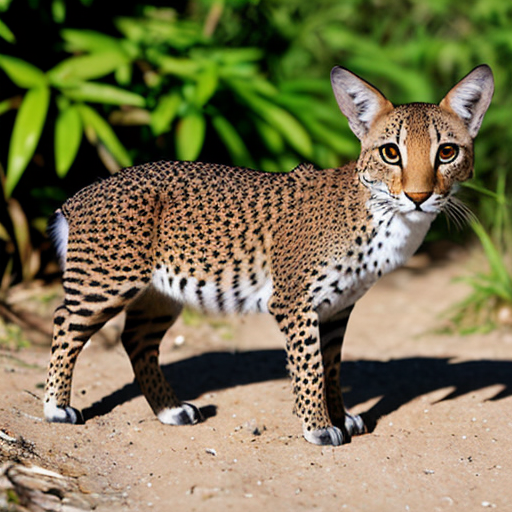
The Enduring Legacy of Dreki in Popular Culture
You can’t escape the influence of these awe-inspiring creatures, with their iron-hard scales and scorched-earth breath, as they continue to inspire modern pop culture from movies to video games.
The dreki, or dragons of Norse mythology, have captured the imagination of people all over the world and continue to be a popular subject for artists and writers.
From the epic battles of the Hobbit to the wizarding world of Harry Potter, the dreki have become a staple of modern fantasy literature and cinema.
They are often depicted as powerful, fire-breathing beasts that pose a formidable challenge to the heroes of the story.
Even in video games, the dreki are often featured as boss battles, requiring players to use all of their skills and strategies to defeat them.
The legacy of these fearsome dragons is truly enduring, and it’s unlikely that they will lose their place in popular culture anytime soon.
Frequently Asked Questions
How did Norse mythology influence the modern portrayal of dragons in popular culture?
As a lover of fantasy and mythology, I’ve always been fascinated by the portrayal of dragons in popular culture. It’s interesting to note that Norse mythology has had a significant influence on the modern portrayal of dragons, especially in Western culture.
From J.R.R. Tolkien’s Smaug to George R.R. Martin’s Drogon, the dragons in these works draw heavily from Norse mythology. The fierce and powerful Norse dragons, or dreki, were often seen as symbols of strength and wisdom, and were even believed to guard treasure hoards.
These characteristics have been passed down to modern depictions of dragons, making them an iconic symbol of fantasy and adventure.
Were there any specific rituals or ceremonies dedicated to Dreki in Norse culture?
To be honest, I’m not entirely sure if there were any specific rituals or ceremonies dedicated to dreki in Norse culture.
However, I do know that dragons played a significant role in Norse mythology and were often seen as powerful and fearsome creatures.
They were believed to possess magical powers and were sometimes worshipped as gods.
It’s possible that some people may have offered sacrifices or performed other rituals to appease these creatures, but I haven’t come across any specific information on this topic.
Regardless, the fact that dragons were such an integral part of Norse mythology speaks to their importance and influence in the culture of the time.
What is the symbolic significance of Dreki in Norse mythology?
As a fan of Norse mythology, I find the symbolic significance of dragons (Dreki) in this culture to be fascinating.
While there isn’t any specific ritual or ceremony dedicated to Dreki, they are often seen as powerful and fearsome creatures that embody strength, wisdom, and protection.
In fact, dragons were often used as symbols on Viking ships and shields to intimidate their enemies.
Additionally, some sagas and myths depict dragons as guardians of treasures or magical objects, further emphasizing their protective nature.
Overall, the symbolic significance of Dreki in Norse mythology highlights the importance of strength, wisdom, and protection in this culture.
Can Dreki be considered as a divine or sacred creature in Norse beliefs?
When it comes to Norse beliefs, it’s important to understand that the concept of divinity and sacredness was not limited to just one type of creature. However, in the case of Dreki, it’s difficult to determine if it can be considered as a divine or sacred creature.
While some stories depict them as powerful and revered beings, others portray them as destructive and feared creatures. It’s possible that the symbolism of Dreki in Norse mythology was more complex than just being classified as divine or not.
Ultimately, the interpretation of Dreki’s significance may vary depending on the context of the story or belief system.
Are there any known variations or sub-types of Dreki in Norse mythology?
When exploring Norse mythology, I found myself curious about the potential variations of the legendary creature known as dreki.
After some research, I discovered that there are indeed different types of dreki, with varying physical attributes and abilities.
One example is the Nidhogg, a dragon that gnaws at the roots of the world tree, Yggdrasil.
Another is Fafnir, a giant turned dragon who hoards treasure.
These variations add depth and complexity to the already fascinating lore surrounding dreki.
Conclusion
So there you have it, the fascinating world of dreki in Norse mythology. As a lover of dragons and mythology, I found delving into the characteristics and abilities of these fearsome creatures to be nothing short of thrilling.
While some may argue that dragons are nothing more than fictional creatures, the rich history and beliefs surrounding dreki in Norse culture prove otherwise.
Now, I can already hear some skeptics saying, “But aren’t dragons just a product of people’s imaginations?” While it’s true that the physical existence of dragons cannot be proven, their impact on various cultures throughout history cannot be denied.
From Norse mythology to Chinese folklore, dragons have played a significant role in shaping our perceptions of power, wisdom, and strength. And whether we choose to believe in their existence or not, one thing is for sure: the legacy of dreki in popular culture will continue to captivate and inspire generations to come.

